“The secret of getting ahead is getting started,” said Mark Twain. This is true for making your wardrobe space better. You shouldn’t start your day by digging through messy drawers and crowded hangers.
A good wardrobe system does more than look nice. It helps with outfit planning and makes you less stressed. When everything is in its place, you save time and money by not buying things twice.
Organizing expert Ashley Murphy from NEAT Method says an organized closet saves time and money. It helps you avoid buying things you already have. This makes your mornings less stressful and saves you money in the long run.
This guide will show you how to make a wardrobe system that fits your life. You’ll learn how to start and keep your closet organized. You’ll find tips for closet organization that turn messy spaces into organized places.
Key Takeaways
- An organized wardrobe saves time during daily outfit selection and reduces morning stress
- Proper storage systems prevent duplicate purchases and help manage clothing budgets effectively
- Strategic outfit planning becomes easier with visible, well-arranged clothing displays
- Regular maintenance keeps your wardrobe system functional and clutter-free
- Professional organizing principles can be applied to any space size or budget
- Categorizing items by type, color, and frequency creates intuitive storage solutions
Assessing Your Current Closet Situation
Starting a closet makeover means first checking out your current space. You can’t make a good closet system without knowing what you have. This step saves time, money, and stress later.
Professional organizer Lisa Adams says a key rule: count and measure everything you own. This includes shoe sizes, hat widths, and all storage space. Knowing your closet’s size is key for planning storage that fits.
Taking Inventory of Your Space
Begin by making a detailed list of what’s in your closet. Take everything out and sort items into groups. This helps you see what you need to store.
- Hanging clothes – dresses, suits, shirts, and pants that wrinkle easily
- Folded items – sweaters, t-shirts, jeans, and casual wear
- Shoes – count pairs and note different heel heights
- Accessories – belts, scarves, jewelry, and bags
- Seasonal items – coats, swimwear, and holiday clothing
Keep track of how many items you have in each group. This helps figure out how much space you need. Understanding your closet storage needs is easier with numbers.
Identifying Problem Areas
Find common problems that make your closet hard to organize. Most people face similar issues. Knowing these helps you solve them better.
Overcrowding is a big problem. Too many clothes make it hard to see what you have. Clothes get wrinkled, lost, or damaged.
Poor access is another issue. If you can’t reach items or they’re hidden, your closet isn’t useful. Note which areas are hard to get to and why.
The biggest mistake people make is trying to fit too much into too little space without considering how they actually use their clothes.
Wasted vertical space is common too. Many closets have unused space that could be used with the right solutions.
Measuring Your Closet Dimensions
Getting your closet’s measurements is key for planning. Use a tape measure to get your closet’s exact size, including any odd shapes.
Measure these important areas:
- Overall dimensions – width, depth, and height of the entire space
- Hanging rod height – distance from floor to existing rods
- Shelf spacing – gaps between existing shelves
- Door clearance – space needed when doors open
- Obstacles – light fixtures, vents, or structural elements
Keep these measurements in a notebook or app. You’ll use them a lot when looking for storage or planning your layout. Pros always double-check to avoid mistakes.
Think about the height of your tallest items. Long dresses and coats need different space than shirts. Boots need more space than flats. These details are important for your perfect closet system.
Decluttering Your Wardrobe Effectively
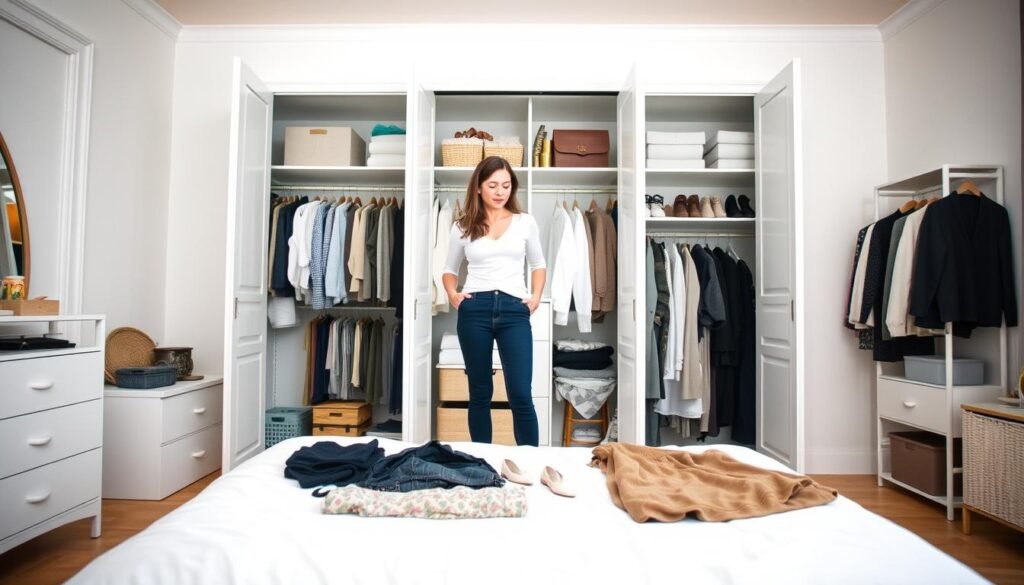
Starting to declutter your wardrobe is all about using proven methods. These help you decide what to keep and what to let go of. Effective decluttering makes room for items you love and wear often, turning your closet into a place of order.
Experts have developed systems to simplify wardrobe choices. These methods help you see clothes objectively, based on your current and future needs.
The One-Year Rule Method
The one-year rule is a simple yet effective way to declutter. If you haven’t worn something in a year, it’s time to consider letting it go. This rule helps you see what fits your lifestyle and what doesn’t.
Ashley Murphy, a professional organizer, suggests getting rid of clothes that are damaged, don’t fit, or haven’t been worn. The rule helps you spot clothes that didn’t make it into your regular rotation.
To use this method, check the tags on your clothes or use a tracking system. Turn hangers backward at the start of each season. Then, flip them forward as you wear items. This makes it clear which clothes you haven’t used.
Sorting Items by Category
Sorting clothes by category makes it easier to decide what to keep. Put all similar items together – like all jeans, blazers, or shoes in one spot. This helps you spot duplicates and understand your shopping habits.
Lisa Adams suggests the “five outfit rule” for sorting. If you can make five different outfits with an item and will wear them, keep it. This ensures every piece in your closet is useful.
Begin with easier categories like workout clothes or formal wear. The KonMari Method advises handling items physically. Notice how you feel about each item – if it makes you happy, keep it.
Deciding What to Keep, Donate, or Discard
Sorting items into three piles makes decision-making easier. The “keep” pile should have items you love, wear often, and feel good in. These clothes fit well and match your lifestyle.
Donation candidates are quality items that don’t fit your needs anymore. Consider clothes that are too small or large, or outdated styles. High-quality pieces deserve new homes.
The discard pile is for items that are damaged, stained, or worn out. Some items can be recycled, while others need proper disposal.
- Keep: Well-fitting, frequently worn, joy-sparking items
- Donate: Good condition pieces that don’t suit your current lifestyle
- Discard: Damaged, stained, or worn-out items beyond repair
- Consign: High-value pieces in excellent condition for extra income
These tips lay the groundwork for a sustainable closet. Effective decluttering isn’t about having fewer items – it’s about keeping what enhances your life. With practice, the process gets easier, and you’ll enjoy lasting satisfaction and improved routines.
Planning Your Closet Organization Layout
Before you start, map out your dream closet layout. This saves time and avoids mistakes. A good plan means every item has its place, making your space more useful.
Experts say a layout should fit your life and habits. Your closet should help you, not hinder you. Planning well helps you keep your space organized.
Creating Zones for Different Item Types
Start by dividing your closet into zones for different clothes. This makes storage easier and more logical. Experts say to sort clothes by type, not just throw them in.
First, list your main clothing groups. These are work clothes, casual wear, and formal outfits. Don’t forget shoes and accessories. Each group should have its own area to stay organized.
Think about your morning routine when setting up zones. Put work clothes and shoes together. This makes getting dressed easier and less stressful.
Prioritizing Frequently Used Items
Put your most-used items where you can easily reach them. These should be at eye level. Less-used items can go up high or in the back.
Look at your past month’s clothes to see what you wear most. These items should be easy to find. Shoes you wear daily should be at floor level.
Items you don’t wear often can go up high or in the back. This keeps your daily clothes accessible.
Sketching Your Ideal Layout
Make a simple sketch of your closet plan. Use graph paper or a drawing app. This helps you see how it will look before you start.
Include measurements in your sketch. Mark where shelves and rods are. Note which items go where. This helps avoid mistakes and makes the most of your space.
Show your sketch to family members who use the closet. They might have ideas you haven’t thought of. Collaborative planning leads to a better closet for everyone.
Essential Storage Solutions and Tools
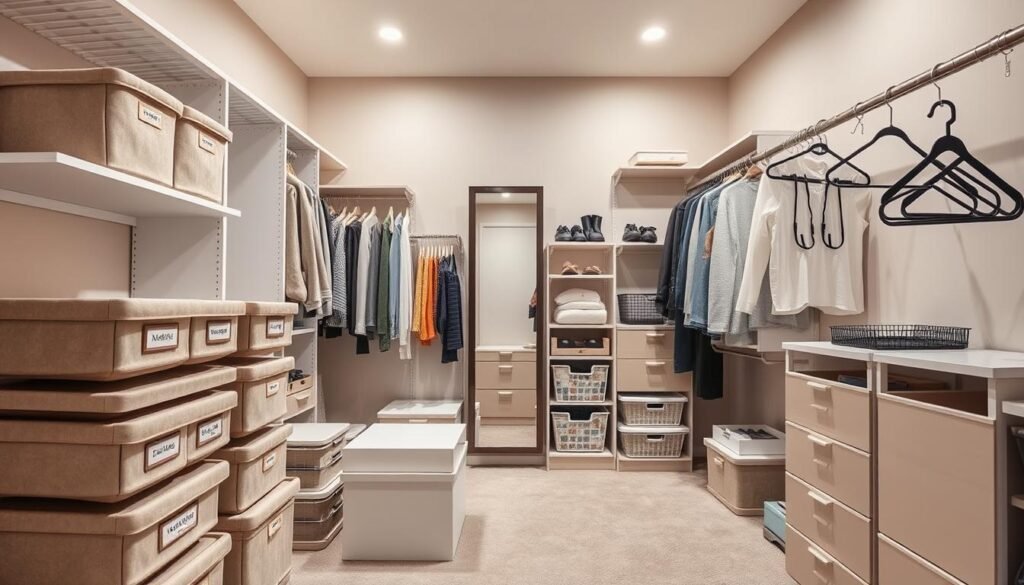
The right storage solutions can turn a messy closet into a tidy space. Professional organizers use specific tools and systems to make the most of space. Knowing which products are best for you helps you spend your money wisely.
Quality tools are the base for lasting organization. It’s important to pick versatile items that fit your changing wardrobe. Smart shopping for these essentials saves money and gives you professional results.
Hangers and Hanging Systems
Marissa Hagmeyer from NEAT Method says matching slimline hangers are key to more closet space. These thin hangers can double your hanging space compared to thick ones. Velvet hangers also prevent clothes from slipping while staying slim.
Different clothes need different hangers for the best care. Heavy coats need strong wooden hangers. Delicate blouses do well with padded hangers. Pants hangers with clips keep trousers smooth and organized.
Cascading hangers greatly increase your vertical space. They let you hang many items in the space of one. They’re great for tank tops, scarves, or other lightweight items.
Shelving and Drawer Organizers
Adjustable shelving systems fit your storage needs. Wire shelving is good for clothes and shoes because it lets air in. Wood shelving looks nicer for visible storage. Both can change as your wardrobe tips and needs change.
Drawer dividers make messy drawers neat. They’re perfect for underwear, socks, and accessories. Expandable versions fit different drawer sizes without needing exact measurements.
Shoe racks and cubbies keep shoes easy to find and safe. Over-the-door shoe organizers use vertical space well in small closets. Clear shoe boxes stack neatly and keep shoes visible and dust-free.
| Storage Type | Best For | Space Efficiency | Budget Range |
|---|---|---|---|
| Slimline Hangers | All hanging clothes | Doubles hanging space | $15-40 |
| Adjustable Shelving | Folded items, shoes | Maximizes vertical space | $30-100 |
| Drawer Dividers | Small items, accessories | Organizes existing space | $10-25 |
| Clear Storage Bins | Seasonal items | Stackable efficiency | $20-60 |
Bins, Baskets, and Containers
Clear storage bins make managing seasonal clothes easy. You can see what’s inside without opening them. These storage solutions stack well and keep clothes dust-free. Label each bin for quick identification.
Woven baskets add style and function. They’re perfect for bulky items like sweaters or blankets. Natural materials match any closet style while keeping things organized. Choose baskets with handles for easy moving.
Small trays keep accessories sorted. They’re great for jewelry, watches, belts, and other small items. Velvet-lined trays protect delicate pieces and keep them visible. Stackable trays save drawer space.
Vacuum storage bags shrink bulky items a lot. They reduce volume by up to 75% for things like comforters and winter coats. They also protect items from moisture, dust, and pests.
Think about your lifestyle when picking containers. Busy people need quick-access solutions. Families with kids need durable, easy-to-use options. Wardrobe tips from pros say choose quality items that last through daily use and frequent reorganizing.
Master Closet Organization Step-by-Step
To make your closet organized, follow a proven plan that pros use every day. This method turns messy closets into useful storage spaces. It involves four key steps that build on each other.
Heather Aiello, a pro organizer, says closet organization needs patience and dedication. Each step is important for a lasting system. Rushing can lead to poor results that don’t last.
Empty and Clean Your Closet
Start by emptying your closet completely. Take out all clothes, shoes, accessories, and storage. Don’t forget hangers and organizers.
Emptying helps you decide what to keep. You’ll find forgotten items during this step.
After emptying, clean every surface well. Dust shelves, vacuum the floor, and clean surfaces with a cleaner. This makes your closet ready for new organization.
Install Storage Solutions
Now, install your chosen storage solutions. Plan carefully and use the right tools for a good fit and function.
Start with big items like shelving or closet systems. These are the base of your closet organization. Measure twice and install once to avoid mistakes.
Then, add smaller items like drawer dividers and hangers. These details make your system great. Quality installation here prevents future problems.
Organize by Category and Frequency
Next, put items back in your closet in a smart way. Group similar items together. This makes finding things easier.
Put often-used items where you can easily reach them. Work clothes and everyday wear should be easy to find. Less used items go higher up.
Think about your daily routine when placing items. Morning workout clothes should be easy to find. Evening wear can be harder to reach.
Implement a Color-Coding System
The last step is to make your closet look good and work well. Use color-coding for this. It’s not just for looks.
Organize clothes by color, from light to dark. This helps you find items quickly and see if you have too many of one color. You’ll see wardrobe gaps too.
Use color-coding for accessories and shoes too. A consistent system makes your closet easy to use and keep up over time.
| Organization Step | Time Required | Essential Tools | Key Focus |
|---|---|---|---|
| Empty and Clean | 2-3 hours | Vacuum, cleaning supplies, boxes | Complete removal and deep cleaning |
| Install Storage | 3-4 hours | Drill, level, measuring tape, screws | Proper installation and measurements |
| Organize by Category | 4-5 hours | Labels, containers, hangers | Logical grouping and accessibility |
| Color-Coding System | 1-2 hours | Good lighting, patience | Visual appeal and quick identification |
By following these steps, your closet will be organized. Each step is important for a complete system. The effort will make getting dressed easier and less stressful.
Maximizing Small Closet Spaces
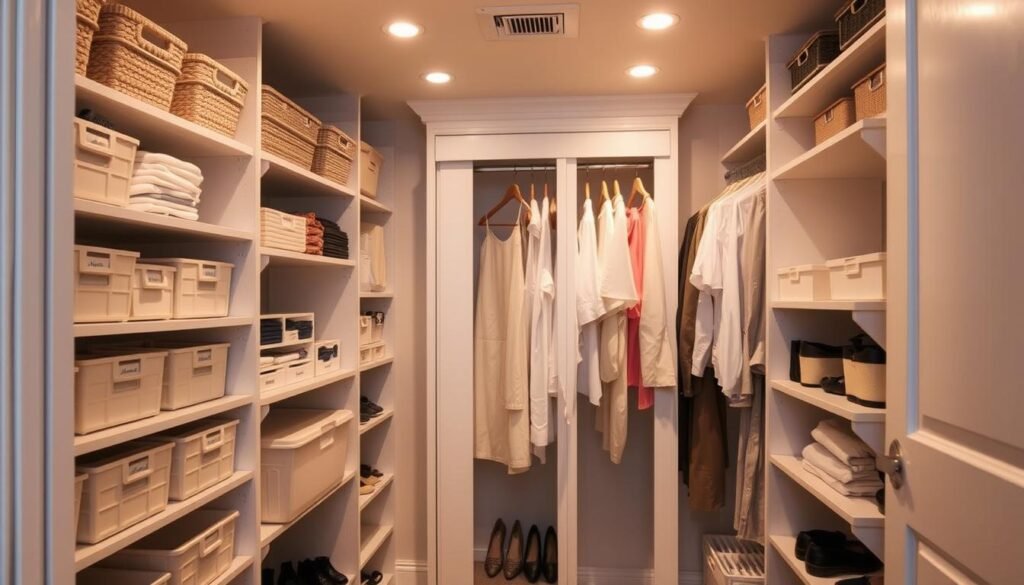
Even with limited closet space, you can stay organized with the right storage solutions. Small closets can be very useful with smart planning. The trick is to use every inch and keep things easy to find.
Experts say to think outside the box when organizing closets. See your closet as a three-dimensional puzzle. Use every inch of space, both up and down, to keep things tidy.
Vertical Storage Strategies
Vertical space is key in small closets. Adding double hanging rods can double your storage space. This is a simple way to make more room.
Stackable shelves are great for folded clothes. Place them from floor to ceiling for easy access. Adjustable shelving grows with your needs.
Putting a dresser under hanging clothes is a smart move. It uses negative space and adds drawer storage. Choose a dresser that fits under most rods, 30-36 inches tall.
The secret to small closet success is thinking vertically first, then horizontally. Every inch counts when space is limited.
Multi-Purpose Storage Solutions
Multi-functional furniture is perfect for small spaces. Ottoman storage benches offer seating and hide items. Rolling carts hold accessories and move when needed.
Hanging organizers with pockets save rod space. They’re great for undergarments and workout clothes. These storage solutions keep small items in sight and reach.
Vacuum-sealed bags shrink bulky items like blankets and coats. Store them on high shelves or under clothes. This method can cut storage space by up to 75%.
| Storage Type | Space Saved | Best Use | Cost Range |
|---|---|---|---|
| Double Hanging Rods | 50% more hanging space | Shirts, pants, skirts | $15-$40 |
| Stackable Shelves | 3x vertical capacity | Folded clothes, shoes | $25-$80 |
| Over-Door Organizers | 12-24 pockets | Accessories, small items | $10-$30 |
| Vacuum Storage Bags | 75% volume reduction | Seasonal bedding, coats | $20-$50 |
Utilizing Door and Wall Space
Closet doors are great for storage. Over-the-door shoe organizers can hold up to 24 pairs. Door racks are perfect for ties, belts, and scarves.
Wall hooks and pegs add hanging space. Install them at different heights for various items. Wardrobe tips suggest adhesive hooks for places where drilling is not allowed.
Magnetic strips on metal closet parts hold small metal items. They’re great for jewelry, hair clips, or safety pins. This keeps small items organized and prevents loss.
Install a narrow shelf above your closet door. It’s perfect for handbags, hats, or seasonal items. Keep often-used items at eye level and store less frequent items higher.
By using these strategies, even the smallest closets can become organized and useful. The best storage solutions fit your needs and daily habits.
Seasonal Wardrobe Management
Effective seasonal wardrobe management makes closet changes smooth and organized. It’s all about creating systems that make switching seasons easy and stress-free. Smart closet organization saves time and keeps your wardrobe fresh all year.
Professional organizers suggest planning seasonal transitions two weeks before the weather changes. This allows you to make thoughtful decisions about what to keep and what to store.
Rotating Seasonal Clothing
Begin by pulling out clothes for the upcoming season first. This helps you see what you have before deciding on storage. Focus on the clothes you’ll actually wear instead of everything.
Make a simple rotation schedule that fits your lifestyle. Many people switch wardrobes twice a year – in spring and fall. But if you live in an area with distinct seasons, you might need to rotate more often.
Keep a few off-season items accessible for unexpected weather changes. You don’t want to dig through storage boxes when the weather surprises you.
Proper Storage for Off-Season Items
Professional organizers suggest storing off-season items in labeled bins or boxes. Vacuum-seal storage bags are great for items you don’t use often, like heavy coats or formal wear.
Clean all clothes before storing them. Stains and odors can set in during long storage. Make sure everything is dry to prevent mold and mildew.
Choose storage locations that stay cool and dry all year. Avoid areas with extreme temperature changes. Under-bed storage boxes are convenient and keep your closet organization system intact.
Transitional Piece Placement
Identify versatile pieces that work across multiple seasons and give them prime closet space. These items should be easy to access because you’ll use them often. Think blazers, cardigans, and medium-weight pants that work well in different seasons.
Put transitional pieces in easy-to-reach areas of your closet. This makes outfit planning quicker and more intuitive. Closet organization becomes easier when you can find what you need fast.
Consider a special section in your closet for transitional pieces. This makes it easy to find the right outfit for those tricky weather days. Your future self will appreciate this planning.
Styling and Outfit Planning Systems
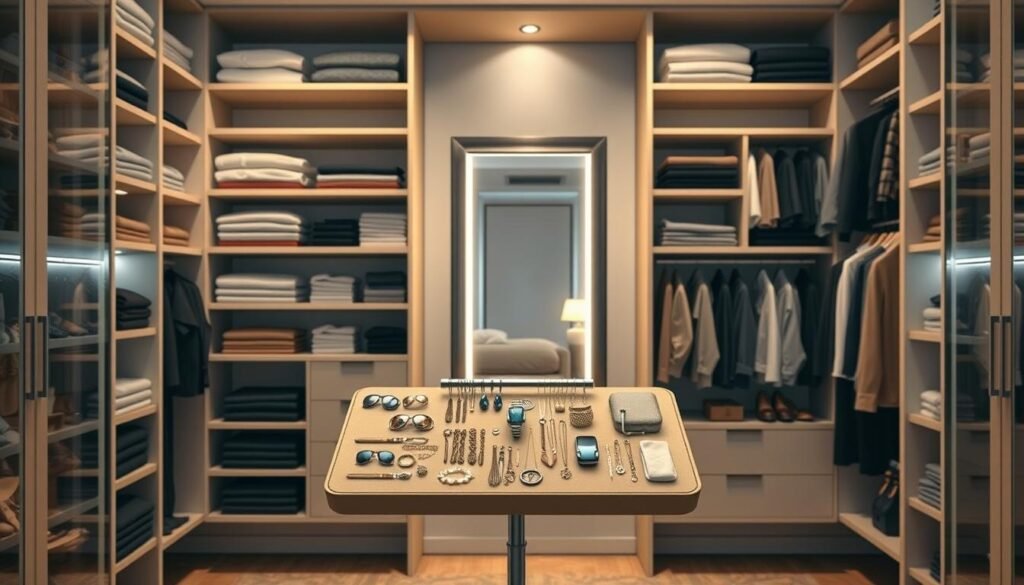
Effective outfit planning turns your closet into a style strategy. When you organize your wardrobe well, getting dressed becomes easy and fun.
Seeing how your clothes can be mixed is key. Smart organization methods help you spot outfit ideas quickly. This makes mornings more enjoyable.
Creating a Capsule Wardrobe
A capsule wardrobe is the base for easy styling. It focuses on quality over quantity. You choose pieces that go well together.
Start with a color palette of three to five colors. Neutrals like navy, black, white, and beige are good. Add one or two colors that show your style.
Pick essential items that can be worn in different ways:
- Classic blazers for work and casual days
- Dark wash jeans that fit well
- Dresses for different places
- Basic white shirts and cozy sweaters
- Stylish shoes for all activities
Put these pieces in your closet where you can see them. Visual accessibility makes mixing clothes easy.
Outfit Planning and Coordination
Good outfit planning starts with knowing your week. Organize clothes by occasion and how often you wear them. This makes choosing outfits easier.
Use Lisa Adams’ method to organize clothes by type, color, and formality. This system helps you find the right outfits fast.
Make outfit formulas for your life:
- Professional look: Blazer + blouse + tailored pants + closed-toe shoes
- Casual weekend: Jeans + sweater + sneakers + crossbody bag
- Date night: Dress + jewelry + heels + clutch
- Exercise routine: Moisture-wicking top + leggings + supportive shoes
Plan outfits the night before busy days. This proactive approach saves morning stress and keeps you looking good.
Accessory Organization and Display
Well-organized accessories complete any look and show your style. Use storage that keeps things visible and easy to find.
Use clear containers or open displays for often-worn items. Necklaces need hooks or stands to avoid tangling. Earrings fit well in trays or hanging organizers.
Organize accessories by type and color for easy pairing. Keep everyday items like watches and simple jewelry at eye level. Special occasion accessories can be stored higher or lower.
These wardrobe tips turn your closet into a styling station. Smart systems make dressing up fun, not stressful. You’ll look and feel great every day.
Budget-Friendly Closet Organization Ideas
Creating an organized closet doesn’t have to be expensive. You can use affordable alternatives to transform your wardrobe space. Think creatively and use what you already have at home.
Many storage solutions can be made or bought cheaply. The trick is to know where to look and adapt everyday items for your needs.
DIY Storage Solutions
Building your own storage solutions saves money and lets you customize. Wooden crates can be stacked to make modular shelving. Sand them and paint to match your closet’s look.
PVC pipes are great for shoe organizers when cut and mounted. Use cardboard boxes to make drawer dividers for underwear, socks, and accessories.
Tension rods add extra hanging space without needing to drill. They’re perfect for hanging tank tops, scarves, or belts. This is great for rental properties where drilling is not allowed.
Repurposing Household Items
Many items in your home can be turned into closet organization tools. Coffee cans are great for belts, ties, or scarves. Just remove labels and cover with paper for a nice look.
Old dresser drawers can be mounted as unique shelves. Ice cube trays are perfect for jewelry. Clear plastic containers from takeout meals can organize drawers.
Shower curtain rings on hangers hold tank tops or camisoles. Magazine holders store clutches and small purses. These ideas cost almost nothing and often work better than expensive ones.
Shopping Smart for Organization Tools
Smart shopping can find quality storage solutions at good prices. IKEA’s Boaxel system is affordable and lets you start small and add more later. It’s better built than wire systems at big-box stores.
Dollar stores have useful items like bins, baskets, and drawer organizers. Look for basic functionality when shopping on a budget. Quality basics often last longer and work better than fancy gadgets.
End-of-season sales at home improvement stores offer big savings. Stock up on hangers, bins, and shelves during these sales. Thrift stores and garage sales also have great deals.
Buying items in bulk saves money. Hangers, bins, and containers cost less per unit when bought in large quantities. This creates a cohesive look.
Measure your space and make a list before buying. Start with the most important items that will make the biggest difference in your closet organization. You can add more as your budget grows.
Remember, effective organization is about smart planning, not expensive products. Focus on items that solve your specific storage problems, not buying everything at once.
Maintaining Your Organized Closet
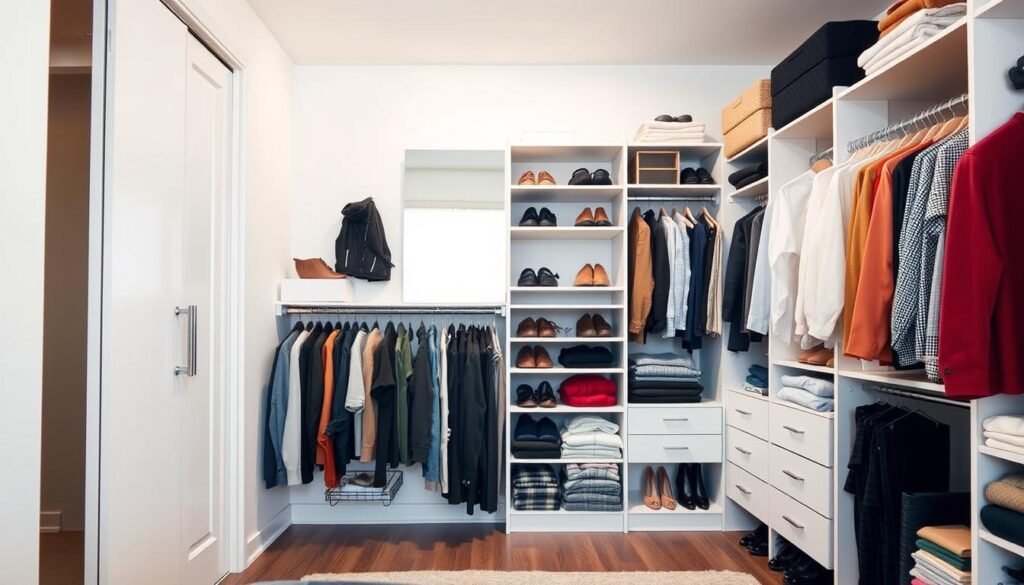
Keeping your closet organized for the long term means setting up habits that fit your life. Shantae Duckworth says closet organization is fluid and not written in stone. This means you can change your system as your needs change.
Building routines that last is key. Small daily actions have a bigger impact than big cleaning sessions. It’s better to make habits that feel easy, not hard.
Daily Habits for Closet Maintenance
Begin each day with a quick five-minute closet check. Hang up clothes right after trying them on. This stops the chair pile problem.
Duckworth suggests using a “stil clean” basket for items you’ve tried but not worn. This keeps your closet neat and makes it easy to find things you’ve recently considered.
Lisa Adams advises editing almost daily, not just seasonally. Deal with items that don’t fit or show stains right away. This keeps your space organized.
End your day by putting things back where they belong. Make this part of your bedtime routine. Sticking to these small steps helps avoid big messes.
Weekly and Monthly Organization Tasks
Do a weekly closet check to see what’s working and what’s not. Look for items you often forget. These might need a better spot or to be removed.
Monthly, do deeper cleaning and make system changes. Vacuum the floor and clean shelves. Also, check your outfit planning to find any problems.
Seasonal changes need extra attention. Switch out clothes based on the weather. Store away-season items to keep them in good shape.
| Frequency | Task | Time Required | Impact Level |
|---|---|---|---|
| Daily | Hang clothes immediately | 2-3 minutes | High |
| Daily | Use “stil clean” basket | 1 minute | Medium |
| Weekly | Closet review and adjustment | 15-20 minutes | High |
| Monthly | Deep cleaning and system check | 30-45 minutes | Medium |
| Seasonally | Wardrobe rotation | 2-3 hours | High |
Preventing Future Clutter Buildup
The best way to avoid closet mess is to be proactive. Use the one-in, one-out rule for new items. This keeps your closet balanced without overcrowding.
Regularly check your wardrobe to see what you buy. Notice what you often give away or never wear. This helps you make better shopping choices.
Set limits for different types of items. When a section gets too full, it’s time to sort, not add more. Choose quality over quantity in your wardrobe.
These tips work best when they become second nature. Start with one or two habits and add more as they become automatic. Your closet will stay organized with consistent care.
Common Closet Organization Mistakes to Avoid
Knowing what not to do is as important as knowing what to do when organizing your closet. Many people fall into traps that waste money and cause frustration. Learning from these mistakes can save you time, money, and headaches, making your closet organization project a success.
Overcomplicating Organization Systems
The biggest trap is creating overly complex systems that look good but fail in daily use. You might plan an elaborate color-coding scheme. But if it takes too long to put away a shirt, you won’t stick with it.
Simple systems are better for lasting success. Grouping similar items together is easier and more effective than complicated filing systems. Remember, you’ll use this system when you’re tired, rushed, or distracted.
Many forget they can adjust their closet’s features. Adjustable shelves and hanging rods offer flexibility without needing new products. Before buying complex storage solutions, see what your current space can do.
Ignoring Your Lifestyle Needs
Your closet organization should fit your real life, not an ideal. If you work from home in casual clothes, don’t waste space on business suits. Honest self-assessment prevents wasted effort and money.
Consider your daily routines when planning storage. If you dress in dim light, simple systems are better. If you travel often, prioritize easy packing over perfect displays.
Think about your future plans too. The Container Store’s Elfa system is great but best for those staying put for at least five years. Match your organization investments to your lifestyle timeline.
Family dynamics also play a role. A system perfect for one person might be chaos for kids or roommates. Design organization that works for everyone who uses the space.
Buying Too Many Organization Products
The most expensive mistake is shopping for organization products before understanding your actual needs. Stores make organization look easy with beautiful displays. But buying first and planning second leads to wasted money and cluttered closets.
Start your closet organization with what you already own. Shoeboxes, baskets, and containers from other areas of your home often work well for initial organization. Only buy new products after living with your system for a few weeks.
Avoid the “one-size-fits-all” trap. That amazing organizer from social media might not fit your space or clothes. Measure everything twice and consider your specific wardrobe before purchasing.
Quality matters more than quantity when buying organizers. A few durable, well-chosen products serve you better than many cheap items. Focus your budget on high-impact solutions that address your biggest organization challenges.
Conclusion
Creating the perfect closet changes your daily life in big ways. Experts say it takes effort at first and then upkeep. The benefits, like saving time and feeling less stressed, make it all worth it.
Your closet becomes a key part of your morning routine. It saves you time and makes choosing what to wear easier. The right storage fits your life perfectly.
If the whole project seems too big, start small. Begin with one area or type of clothing. Use what you’ve learned to make progress step by step.
Creating an organized closet is definitely doable. You have everything you need to succeed. The trick is to pick the right storage and keep up with it.
Your future self will thank you for the effort you put in now. An organized closet makes mornings calm and your style choices confident. Start making your closet the organized space you’ve always wanted.

